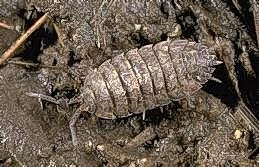By Michelle Ramsey, Butte County Master Gardener, November 15, 2013

Both types of bug range from light to dark gray in color and are between one-quarter and one-half-inch long. They are terrestrial crustaceans with a hard shell-like exoskeleton comprised of seven segmented plates. They have three body parts (head, thorax and abdomen), seven pairs of legs and a pair of appendages at the end of their abdomen (called uropods). Their segmented, oval bodies are convex on top but flat underneath. Because they are crustaceans they breathe through plate-like gills located on the underside of the abdomen. These bugs are the only crustaceans that have adapted to living their entire life on land.
Females have marsupial-like pouches on the undersides of their bodies that can hold up to 100 developing eggs. The immature isopod can remain in the pouch for up to 2 months after hatching. Full development to an adult takes about 1 year. During this time, the isopod will molt 4-5 times. Molting occurs in two stages: first the back half of the exoskeleton molts, then, two to three days later, the front half molts. The life span of both pillbugs and sowbugs is about three years.
Sowbugs and pillbugs are most active at night. They spend daylight hours in moist, dark habitats. Because they breathe through gills, they require a very moist environment. That’s why you will find them hidden underneath rocks, in ground litter, or between the edges of moist grass and sidewalk areas during the day. They do not bite, sting or transmit disease. They are harmless to humans.
Sowbugs and pillbugs are omnivores, mainly feeding on dead or decaying plants and animals, and are therefore considered somewhat beneficial in our gardens for their role in overturning soil and producing compost. However, they have been known to feed on tender plant tissue, seedlings, stems and roots of young garden vegetables and other plants.
Sowbugs and pillbugs are not normally pests. However, if control is required, minimize moisture, clean up debris and decaying matter, and water early in the day so the soil dries out by evening. No moisture - No problem!
For more information, visit: http://www.ipm.ucdavis.edu/PMG/GARDEN/FRUIT/PESTS/sowbugs.html
